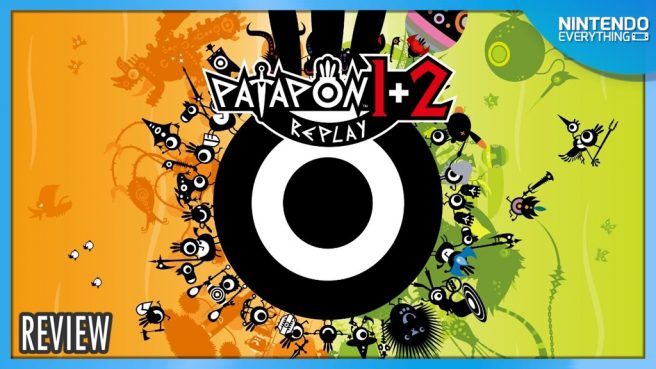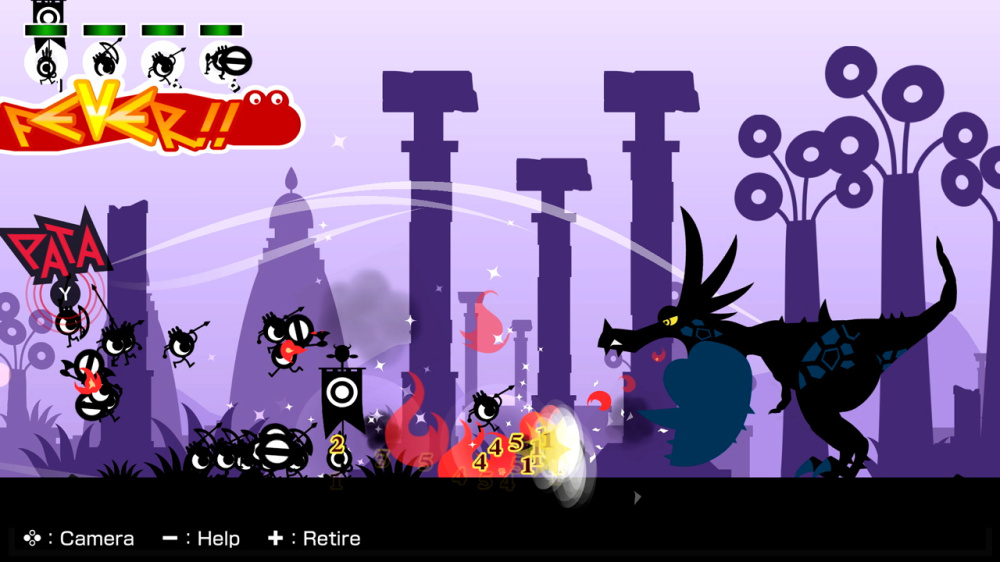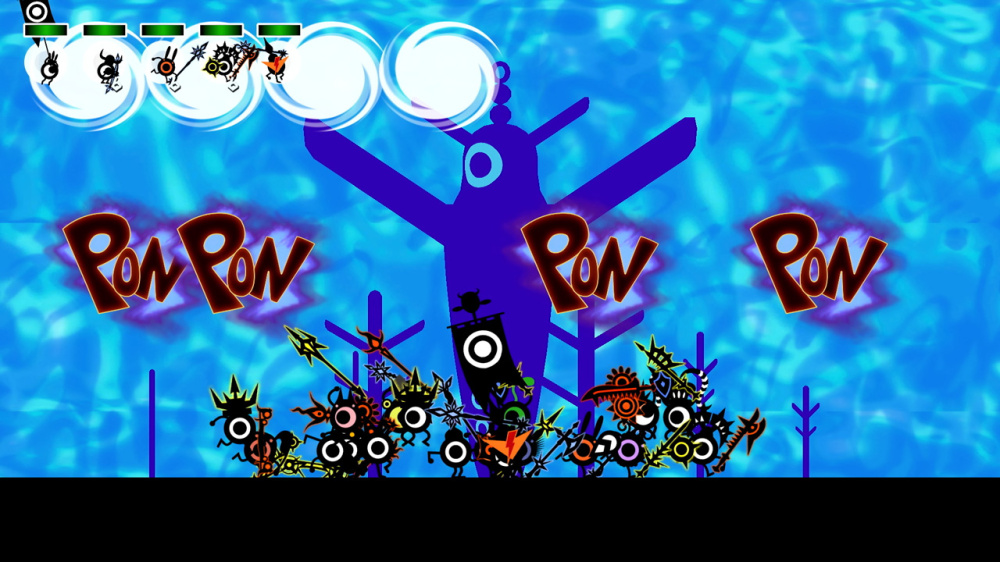System: Switch
Release date: July 22, 2025
Developer: Sas Co / Pyramid / Japan Studio
Publisher: Bandai Namco
Of all the franchises I expected to see on Switch this year, Sony Interactive Entertainment’s Patapon wasn’t one of them. Part rhythm game, part imposing strategy micro-management sim, Patapon is the endearing outcome of a chance encounter between Japanese developer Hiroyuki Kotani and the personal website of French artist Rolito. This fairytale serendipity resulted in Japan Studio, Rolito, and Pyramid developing the original Patapon exclusively for Sony’s PSP in 2007, with a sequel arriving for the same machine just one year later. Now almost twenty years later, Bandai Namco lives up to its apparent reputation as everyone’s best mate by taking the PlayStation exclusive multiplatform. Can someone explain our current timeline to me, please?
I’d hazard a guess that when Patapon slid across the marketing department’s desk at Sony HQ in 2007, PR experts across the entire span of the company simply threw their hands up in the air in exasperated defeat. How do you sell a game like Patapon? How can this humble reviewer explain what Patapon is to you, the reader? It’s a side-scroller, but you don’t directly move your character – you don’t even have a character, you have a drum – see what I mean? Misdirection is perhaps the most accurate high-level descriptor I can tack onto Patapon. What might seem like a cutesy, one-note rhythm action game actually hides a formidable set of layered strategy mechanics.
Gameplay consists of commanding a cycloptic tribe of axe, spear, sword, and bow wielding acolytes using four separate drum-based commands. Each of the Joy-Con’s face buttons are mapped to a specific phonetic drum – Y for Pata, A for Pon, X for Chaka, and B for Don. Linking these sounds into set combos will execute orders for your enthusiastic gang of zealots to follow – Pata, Pata, Pata, Pon for instance, will order your army to advance through the stage. Pon, Pon, Pata, Pon, sets your team on an all out attack. There are only a handful of patterns to memorize – a tangible relief once combat encounters begin ramping up in intensity. Patapon’s depth lies in how much additional control it gives you over your army’s loadout, composition, and even their day to day dealing.
Games like Patapon are one of the main reasons why the PSP ranks as an all-timer amongst my console collection. Much like the Wii, the machine was a safe haven for innovation in the midst of a shifting industry – one that was growing increasingly risk averse. The way in which Patapon builds on simple base elements is a prime example of the kind of production chops present at Sony back during the late 2000s. Outside of directing your little fellas through stages of escalating side-scrolling mayhem, you’ll spend a considerable amount of time back at camp setting them up for success. Strategic dominance begins at Mater, the tree of life, where you can use resources obtained during each mission to effectively breed new Patapons for your army. Think of it as an equitable mid 2000s precursor to the gacha games of today – but instead of summoning anime girls wearing increasingly tiny outfits, you’re rallying a little green cyclops on horse back. The relative cost of recruiting higher end ‘pons can be a little disheartening throughout your first few hours with the game, owing to the repetitive nature of the hunts you repeatedly set out on to accrue more currency. Thankfully once you’ve spent some of that cash (or “Kaching” as the game calls it) and built up your legion, better stages offering better rewards open up to you and your gaggle of little weirdos.
Beyond simply chopping and changing between alternating squads of mono-eyed tribesmen, the gear you acquire throughout the game can be assigned to individual Patapon as you obtain it. This feature is unceremoniously thrust in front of you at the beginning of the first title, and its immediate depth is immediately intimidating. A simple, one-click “Optimize” tool is offered during squad selection, however it doesn’t always do the best job of giving the strongest wee men the best-est stuff. Hopping in manually and tweaking the loadout of each Patapon that you’ve enlisted almost always results in a better mission outcome, and even though it’s admittedly overwhelming at first, it pays to spend some time tinkering with each Patapon’s equipment. The way in which each unit type reacts to the rhythmic commands you belt out on your face buttons also varies greatly, and experimentation is key. Axe-wielding shield bearers respond to the “Defense” command (Chaka-Chaka-Pata-Pon, if you’re wondering) by pushing out in front and raising their shields to protect other units. Archers will always hang back, increasing their arrow output if you stay on beat for a series of chants and activate Fever mode. Did I mention that they chant? In response to each of the sequences you enter, your Patapon excitedly toss their weapons in the air, gleefully calling back the command you’ve just entered. It’s intoxicating, and if you’re anything like me then the mid-tempo backbeat underpinning every moment of Patapon’s gameplay will stick with you long after you’ve put your Switch down for the day.
The innocent charm of the game’s visual design is perhaps the biggest contributor to the misdirection I mentioned at the outset of the review. Pyramid – the team that worked on the game alongside Japan Studio – had just come off of finishing Loco Roco before moving onto developing Patapon, and the same twee kindergarten flair that encapsulated that game is also present in these ones (albeit with a slightly darker edge). Listening to the little Patapon shouting out their call and response – or tripping over themselves if you mess up a sequence – it’s got all the slapstick sparkle of your youngest relative’s end of year school stage show. Patapon’s fundamentally unserious presentation offsets its stern strategy micromanagement and infrequent grind, resulting in a whole that feels less like a game of Command and Conquer and more like an elaborate playdate. About the only way in which Bandai Namco could have improved on the original games would have been by bumping up their audio quality, as it’s the only area in which the presentation suffers. The miniscule memory bandwidth of the PSP circa 2007 resulted in both Patapon 1 and 2 taking a decent hit in this area, and it would have been nice to see some extra effort made to elevate the original via a bump in bitrate. Save for a modest upscale, some font changes, and a dull over-arching options menu, Bandai Namco largely hasn’t meddled with either Patapon game at all. The upshot to this is we get to see two classic handheld gems in all their period-appropriate glory – the downside being the decades old technical makeup of each game (and the lack of an autosave).
About the only other criticism I can muster up for Patapon 1 + 2 Replay is in relation to how the two included games reflect on one another. Patapon’s sequel is a top-to-bottom improvement over the original title – so much so that it almost begins to make its predecessor look bad. There are significant quality of life improvements made to almost all of the game’s core mechanics in Patapon 2, plus a better story, additional minigames, and a more focused approach to squad management that focuses on evolving existing Patopon over recruiting all new ones. It’s wild to me that Pyramid and Japan Studio managed to get the sequel both greenlit and pushed out in just one year – halcyon days, for sure. I understand it’s a tad contrived to say this collection suffers because one of the included games is Just So Good, but I would recommend playing through both games in sequence if you do pick up Patapon 1 + 2 Replay.
There’s a refreshing breeziness to a handheld game that knows it’s a handheld game – and Patapon gracefully executes on that M.O like the best of its ilk. I’m always appreciative of the continued efforts companies like Nintendo, Sony, and Valve make to squeeze big “proper” games onto devices smaller than a shoebox – but there’s value in taking the small concepts and building them out in a modest and thoughtful way, while remaining mindful of the handheld experience. Patapon is a testament to the kind of design talent that once reigned supreme at Sony, and a slightly bittersweet reminder of an industry that no longer exists. What’s that saying – don’t cry because it’s over, smile because you’re playing either Patapon game? Whilst it might not move the needle in the same way as Mario and Sonic’s original jaunt at the Olympic games, the presence of a PlayStation exclusive like Patapon on Nintendo Switch feels like a pretty significant crossover – especially if you’re of a certain vintage. After hours with both games, the bewitching compulsion I have to return to my tribe is beckoning me with a distant cadence – it goes Pata, Pata, Pata, Pon.
Patapon 1 + 2 Replay copy provided by the publisher for the purposes of this review.



